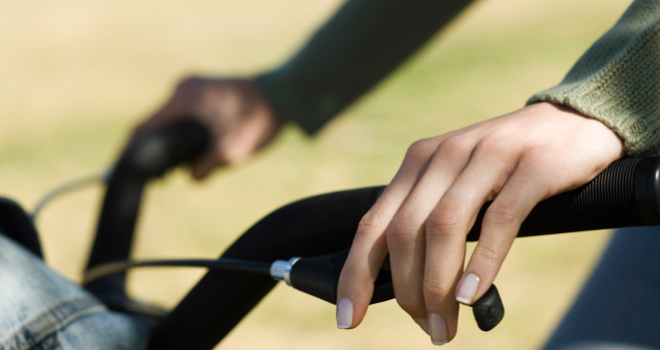By Elizabeth Schiffman
Bike technology has been advancing rapidly to meet cycling’s growing popularity, making frames stronger and lighter, improving shock absorption and streamlining gear mechanisms.
But shifting has yet to diverge from its simple, manual process.
Technology design firm Deeplocal wants to change that by creating a mind-controlled electronic gearshift system.
There are two components to this system that are being developed by the Pittsburgh-based firm: a wireless transmitter mounted below the bike’s seat that controls its gears electronically, and a helmet stuffed with neuron transmitters that’s synced to the control system.
Electroencephalogram (EEG) readouts have been used in the past to control wheelchairs successfully, says Steve Potter, a neuroscience professor at Georgia Tech. He hasn’t heard of EEG signals being transmitted wirelessly, but doesn’t think that that would be a deal-breaker.
This brain-mechanical interface technology is part of a high-tech concept bike sponsored by Toyota to celebrate the Prius’ 10 year anniversary. Intended to be built atop the Prius X Parlee (PXP), an aerodynamic, carbon fiber road bike body designed by Massachusetts-based Parlee Cycles that’s the centerpiece of the project, Deeplocal engineers outfitted a dummy bike with an electronic shifting system.
The onboard electronics are routed through a wireless transmitter, allowing the system to be controlled remotely: first, by a smart phone, and ultimately by the helmet’s outgoing commands. Neuron sensors embedded in the helmet capture and record electrical activity in the brain, reacting to changes in the type and location of activity and generating EEG-style readouts.
Translating those results into commands that can be read by the bike’s control system poses the biggest challenge to the possible commercialization of this idea. Instead of just meditating on a command, like “upshift,” existing neuron sensor-based systems require users to be trained to modulate subtler changes in brain activity.
“The biggest limitation of brain-machine interfacing is that they’re kind of slow,” Potter says. “The maximum amount of data you can get out of an EEG is about 6 bits per minute, and that’s with sensors attached directly to a monkey’s brain, not to the scalp.”
That translates to about 6 “this-or-that” command thoughts per second. So shifting a bike may be possible in that timeframe, he says.
But EEGs need to be tuned to a specific user’s brainwave patterns, and an individual’s signals may look different from day to day, especially if they’re tired or distracted, Potter says. That could limit the effectiveness of the system as the rider loses steam.
The research team hasn’t released the specifics behind their methodology, but the theoretical framework laid by this project could pave the way for more intuitive control systems in the future.
Cycling and design blogger John Watson is tracking the Toyota Prius Project’s concept bike on his blog.
Have a story idea or news tip for Idea Lab? Please send them to Idealab@talkingpointsmemo.com.









